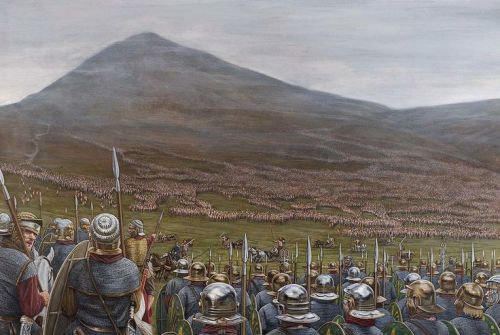Agricola’s battle formation at Mons Graupius.
In AD 84 Agricola aimed to lure the tribes of the Scottish Highlands to battle by threatening the populated, fertile areas bordering the Moray Firth, sometimes using sea-borne raids. The British gathered under the leadership of one Calgacus and took up position on higher ground with the first ranks on the plain and the rest rising in tiers up the slope of a hill. There were also war chariots on the plain. Agricola placed 8000 auxiliary infantry in the centre of his line, with 3000 cavalry guarding the flanks. The legions formed a line in front of the camp wall ready to intervene when required. He also had four cavalry alae in reserve for emergencies.
The battle began with an exchange of missiles, and the Britons displayed both valour and skill in parrying our soldiers’ javelins with their enormous swords or deflecting them with their little shields, while they themselves poured volleys on us. Then Agricola ordered the four cohorts of Batavians and the two of Tungrians to come to close quarters and fight it out at sword point. This was a well-practised manoeuvre for those veteran soldiers, but very difficult for the enemy, who were armed with their small shields and large swords. British swords lack a thrusting point, and are therefore unsuited to swordplay in fighting at close quarters. The Batavians began to rain blow after blow, shove with the bosses of their shields and stab at the faces of their enemies. They annihilated the soldiers on the plain and began to advance up the hill. This provoked the rest of our units to smash in to their nearest opponents and massacre them. Many Britons were left behind half dead or even unwounded, because of the speed of our victorious advance. Meanwhile our cavalry squadrons, after the rout of the war chariots, now plunged right into the infantry battle. By their attack they brought new terror, but the closely packed enemy ranks and the uneven ground soon brought them to a halt. The battle now looked anything but a cavalry engagement, while our infantry struggling for a foothold on the slope was jostled by the flanks of the horses. And stray chariots, with their horses panic-stricken without a driver, often went plunging into the flanks or front.
The Britons who had taken up position on the hilltops had so far taken no part in the battle and, being unengaged, contemptuously noted the smallness of our numbers. They now began to descend slowly and surround the rear of our victorious troops. But Agricola had been concerned about precisely this move, and placed in the path of their advance the four alae of cavalry, which he was keeping back for emergencies. He therefore crushed and scattered them in a rout as severe as their assault had been spirited. So the tactics of the Britons were turned against themselves. The Roman cavalry squadrons, on the orders of the general, rode round from the front of the battle and fell on the enemy in the rear. Then followed an awe-inspiring and terrible spectacle over the open country. Our troops pursued, took prisoners and then killed them when more of the enemy appeared. Among the enemy each man now followed his own inclination. Some groups, though fully armed, fled before smaller numbers, while some men, though unarmed, charged forward and met their death. Weapons, bodies, and severed limbs were scattered everywhere and the earth was stained with blood.
The aftermath of the battle was grim. During the night, while the Romans plundered, the Britons wandered through the countryside trying to recover their wounded and shouting for survivors. When the defeated British fled into woods, Agricola ordered his troops to ring them like hunters. He ordered strong, lightly armed infantry cohorts to scour the woods like a cordon, and where they were thicker dismounted cavalry and where they were thinner mounted cavalry to do the same. But the Britons turned tail when they saw our troops resuming the pursuit in good order with steady ranks. Many abandoned and set fire to their homes, and there was no longer any concerted resistance. In the morning the land was silent and deserted, and the enemy had dispersed in indiscriminate flight. Although Tacitus is more interested in the psychology than in the detail of the battle, this is useful, and doubtless Agricola could supply an account of the crucial incidents. We see how the general is in command of the battle, adapts his tactics, and gives the orders on the deployment of reserves and the conduct of the pursuit. We also see how the infantry and the cavalry had specific tasks to perform in relation to the terrain and the state of the battle, and we learn of the fighting methods and skill of the experienced veterans, who know how to use their swords in a confined space, stabbing at the face while shoving with their shield boss. The attack of the reserve cavalry was the turning point of the battle, and as the British lines broke their army disintegrated in the face of ruthless and well-organized pursuit, which witnessed the killing of prisoners. If Tacitus’ casualty figures are right, his unforgettable picture of the bloodstained battlefield is probably true enough.
